What is Supply Chain Network Design – Implementation Process & Best Practices
For many global businesses, the post-pandemic period has been about putting out fires reactively. Now that things have stabilized, most of our customers stressed that they are ready to address supply chain opportunities more structurally.
What does that mean actually?
Here, let me delve into the intricacies of supply chain network design, a strategic approach that involves the comprehensive planning and structuring of a supply chain. Also, we will shed light on the best practices in this field, emphasizing how advanced analytics, optimization technologies, and sustainability considerations are reshaping the way businesses approach their supply chain networks.
After reading this, you should have answers to:
- What is supply chain network design?
- What to optimize with supply chain design?
- Which are critical objectives besides cost?
- Why data is key?
- What is a supply chain digital twin, and how to design one?
- What does the implementation process look like?
What is Supply Chain Network Design?
Supply chain network design is like the architectural blueprint of your business’s logistics operations. It is the art and science of strategically planning how your products move from suppliers to customers, efficiently and cost-effectively.
This process involves making decisions about where to place distribution centers and manufacturing facilities, and how to best route goods. It’s a bit like a complex puzzle, where you must balance factors such as costs, inventory levels, customer service requirements, sustainability, and risk. Get it right, and you can streamline your operations, save money, and improve customer satisfaction. Get it wrong, and you may end up with inefficiencies, delays, and higher costs.
So, supply chain network design is about making sure your supply chain is not just a chain but a well-orchestrated symphony of interconnected components working in harmony.
These are some practical use cases of supply chain network design that you will leverage:
- Greenfield and brownfield analysis
- Transport mode optimization
- Inventory optimization
- Sensitivity analysis
- Sourcing optimization
- Location risk analysis
When it comes to supply chain network design, cost considerations play a pivotal role in decision-making. These costs encompass various aspects of the supply chain, and understanding and managing them effectively are critical to achieving efficiency and profitability.
- Transportation costs: This includes expenses related to moving goods from suppliers to distribution centers and on to customers. It encompasses freight charges, fuel costs, shipping methods, and transportation routes. Optimizing transportation can significantly impact overall supply chain costs.
- Inventory costs: Maintaining inventory is a necessary expense but can become costly if not managed well. Inventory holding costs, storage expenses, and the cost of capital tied up in inventory are all factors to consider. Balancing inventory levels to meet customer demand without excessive stockpiling is essential.
- Warehousing costs: Rent, labor, utilities, and equipment expenses associated with warehousing facilities are a part of supply chain cost considerations. Decisions about warehouse location, size, and design can impact these costs.
- Production costs: If your supply chain involves manufacturing, the cost of producing goods, including labor, materials, and overhead, is a critical factor. Decisions about where to locate production facilities can affect these costs.
- Handling and packaging costs: These costs involve the labor and materials required for packaging and handling goods within the supply chain, from production to delivery. Efficient handling and packaging can minimize these expenses.
- Taxes and duties: Import and export duties, as well as local taxes in various locations, can impact supply chain costs. It’s important to consider these costs when determining the optimal network design.
- Risk and contingency costs: Unforeseen disruptions, such as natural disasters or supply chain disruptions, can lead to additional costs. Planning for and mitigating such risks is an important part of cost management.
- Environmental and sustainability costs: Increasingly, businesses are factoring in the costs associated with sustainability initiatives, such as reducing carbon emissions or implementing eco-friendly packaging materials.
In supply chain network design, finding the right balance among these cost aspects is essential. Businesses must weigh the expenses against service levels, customer expectations, and strategic goals to create an optimal supply chain network that is both cost-efficient and effective in meeting market demands.
Well, it’s not just about the cost…
Although cost remains a crucial factor in the strategic design of supply chain networks, it is no longer the sole key performance indicator (KPI) that businesses prioritize.
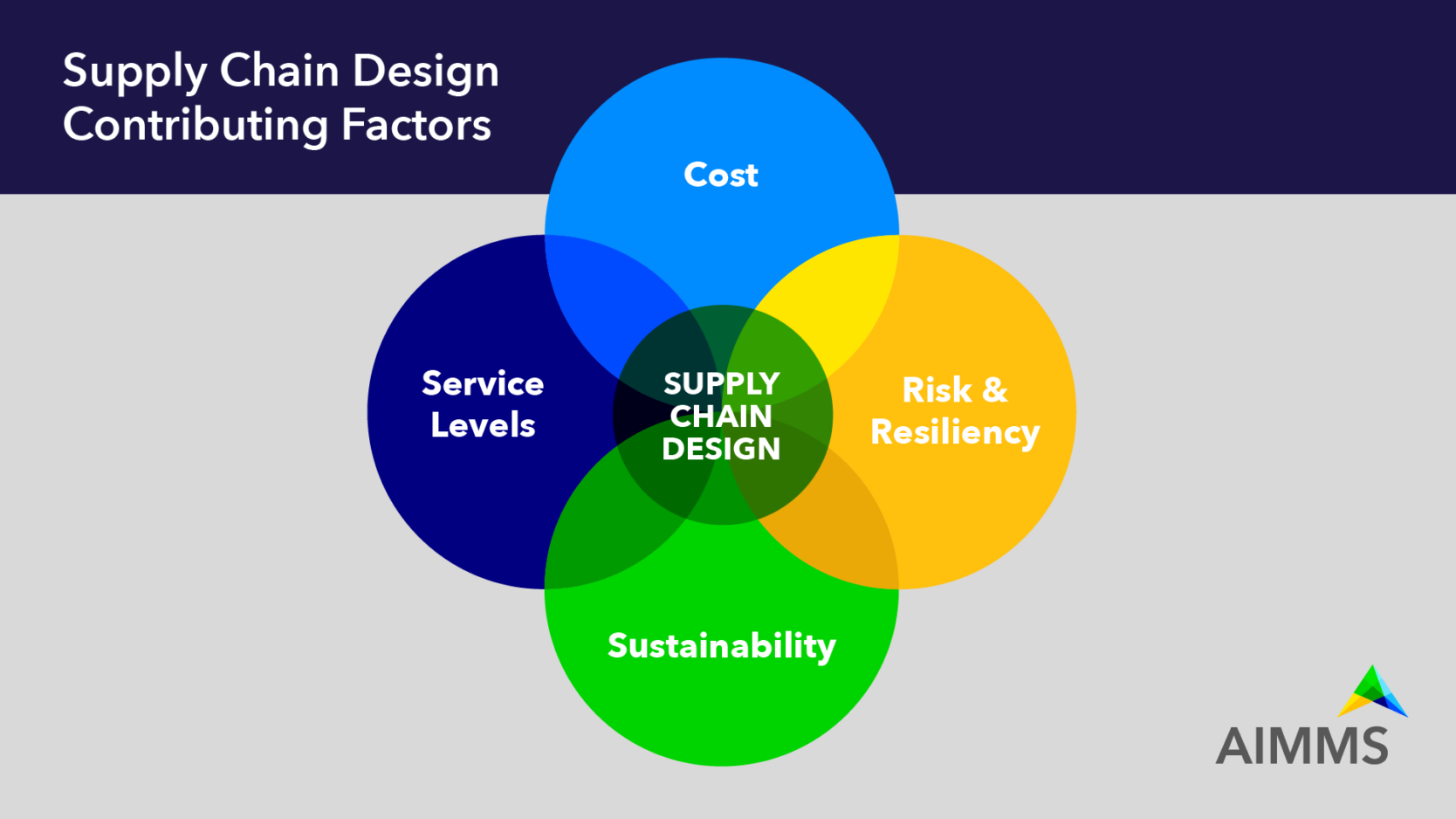
Considering the significant changes, we have witnessed in recent years, companies are expanding their focus to include a broader set of metrics, such as the following.
1. Service levels
Service levels are a critical factor in supply chain network design, as they directly impact customer satisfaction and operational efficiency. Service levels encompass various aspects of delivering products or services, including on-time delivery, order accuracy, lead times, and responsiveness to customer demands.
When designing a supply chain network, it’s essential to strike a balance between cost and service levels. A well-designed network optimizes the trade-offs between inventory, transportation, and warehousing costs while ensuring that service levels meet or exceed customer expectations. Achieving the right service levels can lead to competitive advantages and customer loyalty, making it a central consideration in supply chain network design decisions.
2. Reliability and risk
Reliability is a critical aspect of supply chain network design, as it ensures the consistent and efficient flow of goods and services. In this context, reliability refers to the ability of a supply chain network to withstand disruptions and uncertainties while still meeting customer demand and operational requirements.
A reliable supply chain network can adapt to unexpected challenges, such as natural disasters, supplier disruptions, or changes in customer demand, without significant disruptions to the overall flow of products. Achieving reliability often involves strategies like redundancy, risk mitigation, and robust network design to minimize the impact of unforeseen events, contributing to customer satisfaction and operational resilience.
3. Carbon footprint and ESG
Sustainability is increasingly integral to supply chain network design as businesses recognize the environmental and social impacts of their operations. In this context, sustainability refers to minimizing the carbon footprint, reducing waste, and considering social responsibility in the design and operation of supply chains.
Companies are embracing eco-friendly transportation options, optimizing routes for fuel efficiency, and reducing packaging waste to minimize their environmental impact.
Moreover, they are integrating ethical sourcing and labor practices to enhance the social sustainability of their supply chains. Sustainable supply chain network design is not only environmentally responsible but also aligns with evolving consumer expectations and can lead to cost savings and enhanced brand reputation eventually.
ESG, which stands for Environmental, Social, and Governance, is becoming a central consideration in supply chain network design. Businesses are increasingly recognizing the importance of aligning their supply chain strategies with ESG principles. This involves integrating environmentally responsible practices, considering social impact throughout the supply chain, and maintaining strong governance and ethical standards. ESG considerations in supply chain design encompass reducing carbon emissions, fostering sustainable sourcing, ensuring fair labor practices, and maintaining transparency and accountability in operations.
Companies that prioritize ESG principles in their supply chain network design not only contribute to a more responsible and ethical business ecosystem but also position themselves for long-term sustainability and resilience in a world where ESG factors are gaining prominence among stakeholders, including investors, customers, and regulators.
Data is the key
Data-driven supply chain network design is revolutionizing how businesses optimize their logistics operations. In this approach, decisions regarding the configuration and management of the supply chain are guided by the analysis of vast and real-time data sets.
By harnessing the power of data, companies can make more informed choices about factors like distribution center locations, inventory levels, and transportation routes. This leads to enhanced efficiency and responsiveness, allowing for cost reductions and improved customer service.
Creating Digital Twins
A digital twin is a virtual representation of a physical object, system, or process. It’s a highly detailed and dynamic digital model that mimics the behavior and characteristics of its real-world counterpart.
By providing a real-time, data-driven reflection of the physical world, supply chain digital twins enable better decision-making, predictive maintenance, and the testing of various scenarios without the need for physical intervention. They play a crucial role in the development of smart and interconnected systems, helping organizations gain insights, improve efficiency, and reduce costs.
Creating a digital twin of a supply chain network design involves developing a virtual, data-driven model that replicates the structure and operation of the real-world supply chain.
Here’s how this process works:
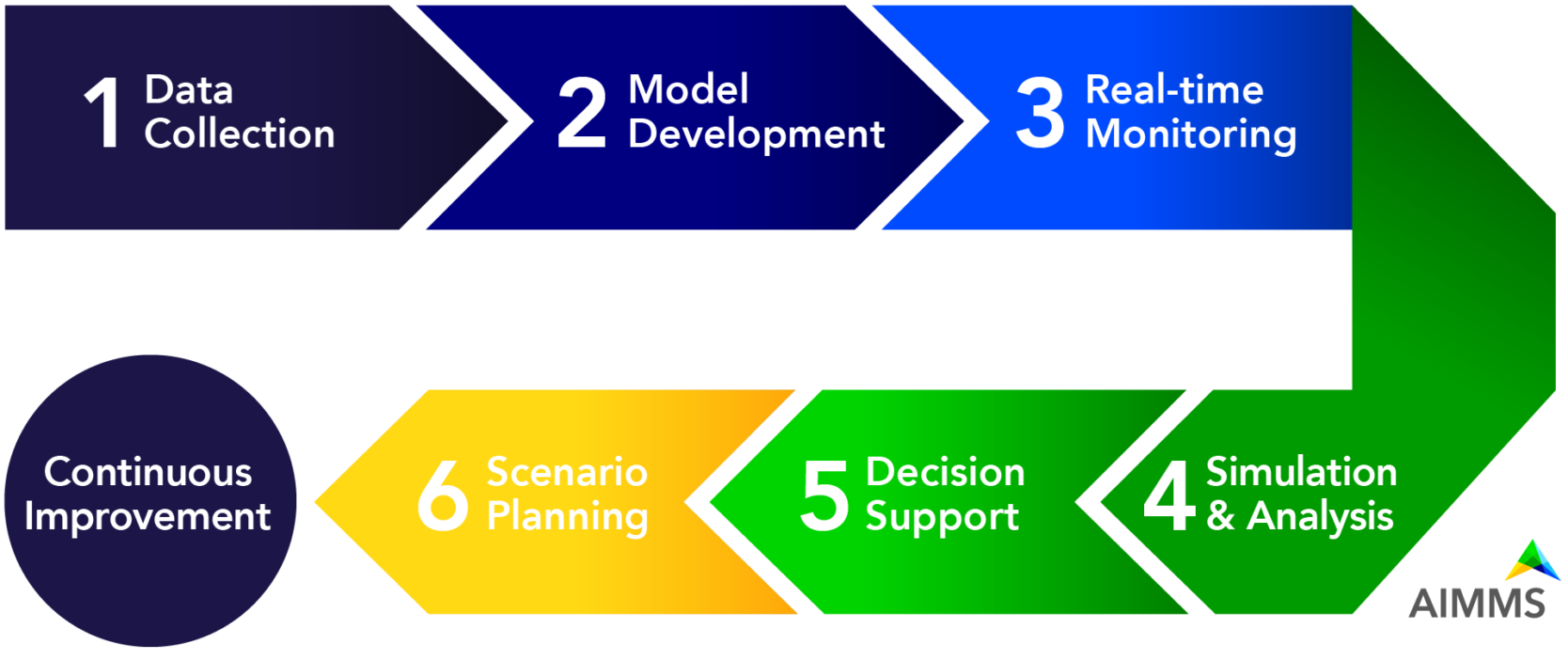
- Data collection: The first step is to collect a wealth of data related to the supply chain, including information on suppliers, production facilities, distribution centers, transportation routes, inventory levels, demand patterns, and performance metrics. This data may come from various sources within the organization and external partners.
- Model development: Using specialized software and tools, a digital twin model is constructed based on the collected data. This model should accurately represent the physical supply chain, including its various components and interrelationships.
- Real-time monitoring: The digital twin is equipped with real-time data feeds that capture information from sensors, IoT (Internet of Things) devices, and other sources. This information helps maintain an up-to-date reflection of the current supply chain, allowing for continuous monitoring.
- Simulation and analysis: With the digital twin in place, businesses can simulate different scenarios, test changes, and analyze the potential impacts of alterations to the supply chain network. This enables predictive analysis, risk assessment, and the optimization of various parameters, such as inventory levels or transportation routes.
- Decision support: The digital twin provides valuable insights and recommendations to support decision-making. For example, it can suggest adjustments to minimize costs, reduce lead times, or enhance overall efficiency.
- Scenario planning: Businesses can use the digital twin to explore “what-if” scenarios, helping them prepare for disruptions, evaluate the introduction of new products, or respond to changes in customer demand.
- Continuous improvement: As the real-world supply chain evolves, the digital twin is updated accordingly, ensuring that it remains an accurate and valuable representation of the network. This iterative process supports ongoing improvements and adaptability.
By creating a digital twin of a supply chain network design, organizations gain a powerful tool for enhancing operational efficiency, reducing costs, and mitigating risks. It enables proactive decision-making and facilitates the development of more resilient and responsive supply chains.
The implementation process
Let’s break down the implementation process into a few steps.

1. Gather all your data
Gathering data to create a baseline and run different scenarios in supply chain network design is a foundational step that involves collecting, analyzing, and leveraging relevant information.
- Pinpoint the sources of data within your organization. This may include ERP (Enterprise Resource Planning) systems, historical sales data, inventory records, transportation logs, and supplier information.
- Collect diverse types of data such as demand patterns, lead times, transportation costs, inventory levels, and order fulfillment accuracy.
- Ensure that the data is accurate, complete, and representative of the current state of the supply chain. Conduct data quality checks to ensure accuracy and consistency.
- Address any discrepancies or missing information to enhance the reliability of the baseline.
The data-driven approach enhances the accuracy of modeling, facilitates informed decision-making, and contributes to the development of an optimized and resilient supply chain.
2. Create a baseline
A baseline serves as a reference point for evaluating the existing supply chain network’s performance. It allows companies to measure the effectiveness of their current operations, identify areas for improvement, and set benchmarks for key performance indicators (KPIs).
Establishing a baseline involves gathering and analyzing data related to various aspects of the supply chain, such as demand patterns, transportation costs, lead times, and inventory levels. This data forms the foundation for accurate modeling and simulation of the supply chain network. With a baseline in place, businesses can compare different supply chain scenarios and assess the impact of proposed changes.
Whether it is adjusting inventory levels, changing distribution strategies, or modifying transportation routes, having a baseline helps in understanding the deviations from the current state. Baselines provide a clear understanding of the current state of the supply chain, aiding decision-makers in making informed choices. By having a baseline, decision-makers can evaluate the trade-offs between different options and select strategies that align with organizational goals.
Baselines provide a starting point for assessing risks in the supply chain. By understanding the current vulnerabilities and weaknesses, businesses can develop strategies to mitigate risks and build a more resilient supply chain network. In summary, creating a baseline in supply chain network design is fundamental for understanding the current state of operations, supporting decision-making processes, and providing a foundation for ongoing optimization and improvement efforts. It sets the stage for effective analysis, modeling, and strategic planning in the dynamic landscape of supply chain management.
3. Run different scenarios
Once a baseline has been established in supply chain network design, running different scenarios becomes a powerful tool for decision-makers. This process involves simulating various hypothetical situations to assess the potential impact of changes or events on the supply chain.
Scenarios can be used to test different optimization strategies. For example, adjusting inventory levels, changing distribution center locations, or optimizing transportation routes. Running these scenarios helps identify the most efficient and cost-effective solutions.
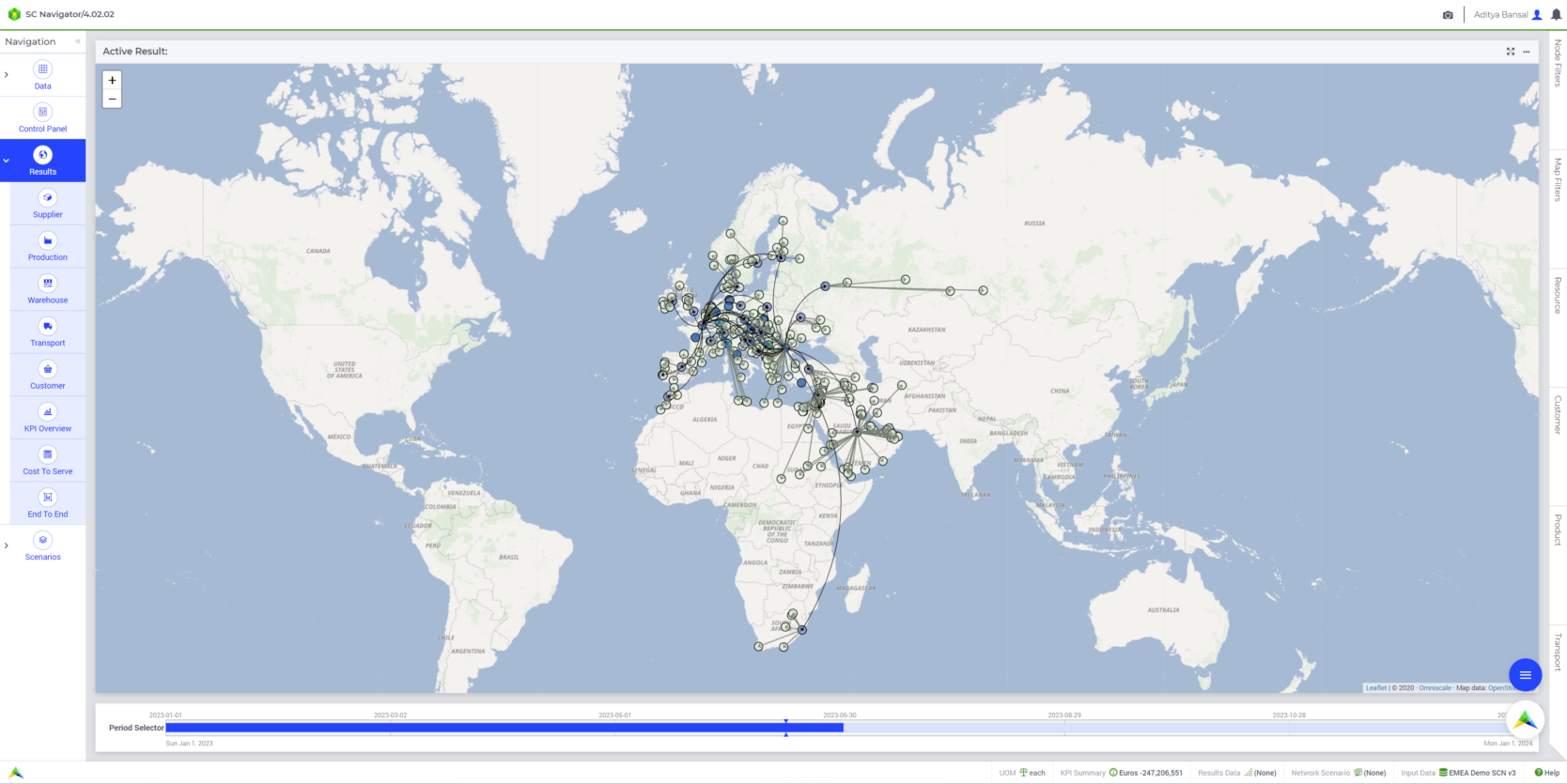
Simulating scenarios with varying demand patterns allows businesses to assess the resilience of their supply chain. This is particularly important in industries with seasonal demand or where market conditions are subject to frequent fluctuations. Evaluate the effects of changes in production capacity, warehouse space, or transportation capacity. This helps ensure that the supply chain can meet demand while avoiding underutilization or bottlenecks.
Assess the impact of changing suppliers or vendors. This includes evaluating lead times, transportation costs, and potential disruptions.
Scenarios can help in making informed decisions about sourcing strategies. Simulate scenarios related to potential risks and disruptions such as natural disasters, geopolitical events, or supplier failures. This allows businesses to develop contingency plans and enhance the resilience of the supply chain. Evaluate the effects of entering new markets or scaling back operations in existing ones.
Scenarios help businesses understand the logistical implications and associated costs of such strategic decisions. Assess the impact of changes in regulations, trade policies, or compliance requirements on the supply chain. This is particularly important in international supply chains subject to evolving global trade dynamics.
Run scenarios to evaluate the impact of incorporating sustainability initiatives into the supply chain. This could involve assessing the environmental footprint, using eco-friendly transportation methods, or adopting sustainable sourcing practices.
By running different scenarios, businesses can gain insights into potential outcomes, risks, and opportunities. This proactive approach helps in making informed decisions, enhancing the agility and resilience of the supply chain, and ensuring it remains adaptable to a dynamic business environment.
4. Compare scenarios and choose the most optimal one
Comparing and choosing the best scenario in supply chain network design is a critical step that involves a careful evaluation of multiple factors.
- Define and prioritize the KPIs that matter most to your business objectives. These could include cost metrics (transportation, inventory, operational), service levels, lead times, and sustainability goals.
- Assign weights to each KPI based on their importance.
- Utilize quantitative analysis to compare the performance of each scenario.
- Evaluate how each scenario performs against the established KPIs and assess the numerical impact on key metrics. This could involve cost-benefit analyses, return on investment calculations, and other quantitative assessments.
- Consider the risks associated with each scenario. Evaluate the potential impact of disruptions, uncertainties, and external factors on the supply chain. A scenario with a robust risk management strategy and the ability to handle uncertainties effectively might be favored.
- While quantitative data is crucial, consider qualitative factors as well.
- Evaluate how each scenario aligns with the overall strategic goals of the organization, its adaptability to future changes, and its compatibility with the organizational culture.
- Involve key stakeholders in the decision-making process. Gather insights and feedback from various departments, including logistics, operations, finance, and sales. Consider the perspectives of those who will be directly impacted by the chosen scenario.
- Assess the feasibility of implementing each Consider the practicality of changes in terms of resources, timelines, and technology requirements. Choose a scenario that aligns with the organization’s capacity for implementation. Evaluate the long-term viability of each scenario.
Consider how well each option positions the supply chain to adapt to future changes, market dynamics, and technological advancements.
Aim for a solution that is sustainable and can withstand evolving business conditions. Plan additional iterations of the most promising scenarios with slight variations to fine-tune and optimize the chosen solution further.
This iterative process can uncover additional insights and help refine the final decision. Establish clear decision criteria and a decision-making framework before the evaluation process. This ensures the final decision is aligned with the organization’s overall objectives and strategic priorities. By carefully weighing quantitative and qualitative factors, involving stakeholders, and considering both short-term and long-term implications, businesses can make well-informed decisions when choosing the best scenario to implement in their supply chain network design. This strategic approach enhances the likelihood of successful implementation and improves overall supply chain performance.
5. Implement it
Implementing the chosen best scenario in supply chain network design is a crucial phase that requires careful planning, coordination, and execution. You will need to:
- Develop a detailed implementation plan outlining the specific steps, timelines, and responsible parties for each aspect of the chosen scenario. This plan should include a clear roadmap for changes to transportation, inventory, warehouse operations, and any other relevant components.
- Locate the necessary resources, including personnel, technology, and financial resources, to support the implementation.
- Establish a robust communication strategy to keep all stakeholders informed about the changes.
- Address concerns and ensure that employees are aware of their roles in the implementation process.
- Consider implementing the chosen scenario on a smaller scale as a pilot program before full-scale deployment. This allows for testing and fine-tuning of the changes, identifying potential issues, and making necessary adjustments before a broader rollout.
- Implement robust performance monitoring systems to track the progress and impact of the changes in real-time.
- Monitor KPIs closely to ensure that the implemented scenario is achieving the expected results.
- Encourage feedback from employees involved in the implementation and be open to adjusting as needed.
- Regularly review performance data to identify areas for optimization and enhancement.
- After the implementation, conduct a thorough review of key performance indicators to assess the success of the chosen scenario and compare the actual results with the expected outcomes.
- Document the entire implementation process, including challenges faced, solutions implemented, and lessons learned. This documentation serves as valuable knowledge for future supply chain initiatives and helps in continuous improvement efforts.
If you want to learn more, our supply chain network design implementation guide offers hands-on advice that will help you achieve successful results. Click on the image below to download the guide.


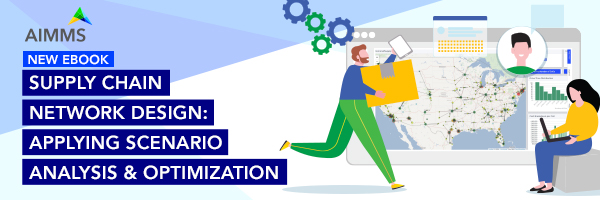




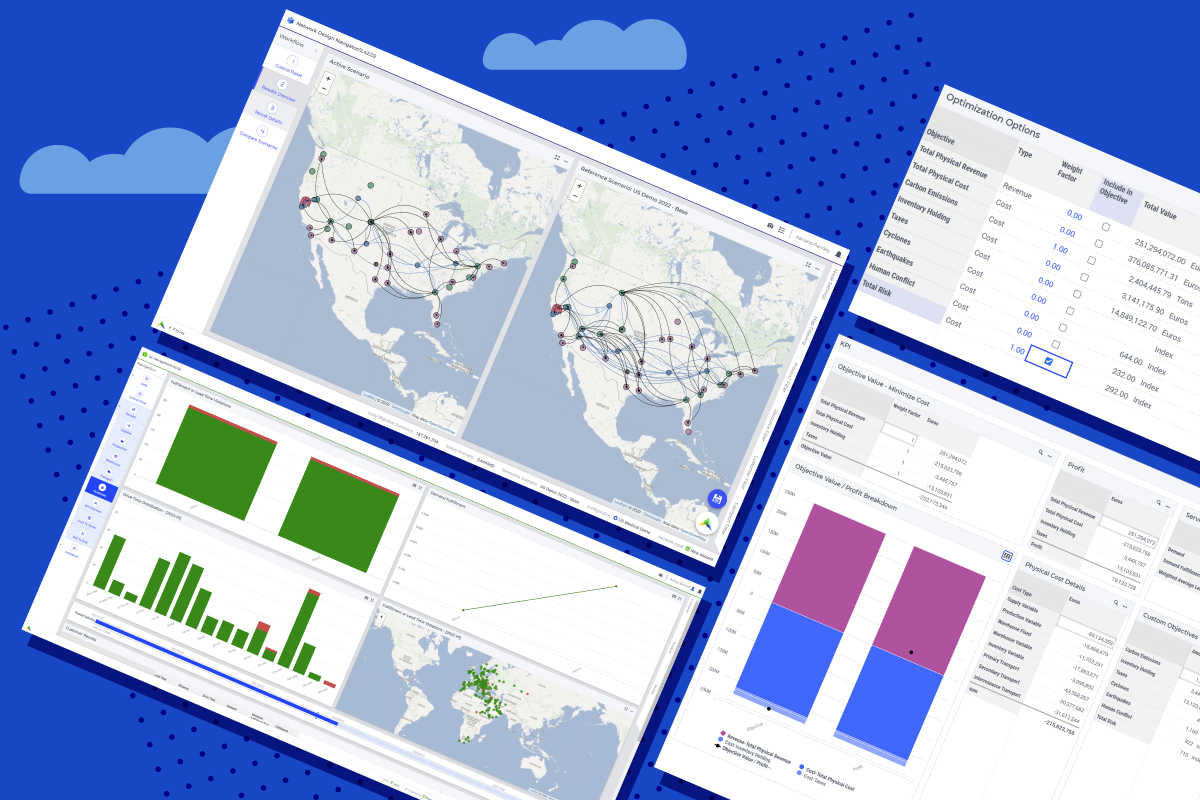
An insightful and comprehensive guide on supply chain network design! Your focus on best practices provides valuable strategies for optimizing efficiency and resilience in today’s complex supply chains. Thank you for sharing such practical knowledge.